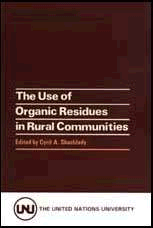
Discussion IV[edit | edit source]
Recommendations of the working groups
The transfer of technology suitable for application at the village level is essential for the maximum use of organic residues. With special reference to ethanol production, the questions concerned the feasibility of distillation, the market potential, and the stability of microbial cultures under village conditions.
Solar heating is the system of choice for distillation; the equipment is not expensive. Ethanol has a market for mixing with motor gasoline as "gasohol" and can also be blended to give satisfactory performance in machinery on the farm.
The Unesco/lCRO Panel on Microbiology has set up centres (MlRCENs) specializing in maintaining standardized pure or mixed cultures that are of interest for fermentation processes in rural areas of developing countries. The focal point is the Microbiological Data Bank in Brisbane, and culture collections are now in Bangkok, Bogor, Cairo, Manila, Nairobi, and Porto Alegre. Dr. Da Silva of Unesco is willing to give further information about the MlRCENs to those interested.
Mushroom production was discussed, and although those described all grow in tropical conditions (38 C), some grow at 15 to 22 C and so are suitable for higher altitudes, The spent compost is a good material for biogas production and is now being evaluated as a feed for ruminant animals. In the mushroomgrowing areas in the Philippines, as much as 85 per cent of the available organic residues is used.
A question was asked about the ability of the mushrooms to degrade the polyphenolic components of straw and their capacity to resist contamination by pathogens in open air cultivation. In reply it was said that the species used in the Philippines seems to degrade lignin quite extensively. Success in cultivation depends on the quality of the spawn: it must be highly viable and resistant to attack by other organisms.
Several participants from different countries were critical of what they called bureaucratic red tape at both central and regional government levels. They considered this to be one of the main barriers to getting new systems and technology into the villages.
It was agreed, however, that if a new technology could be shown to be more profitable than existing practice it would be adopted by the farmer. The only way of convincing him is to prove it by practical demonstration. Technology cannot be transferred on the basis of a theoretical discussion.
Recommendations of the working groups[edit | edit source]
The three initial working groups made recommendations for a number of research and development projects, as follows:
Working Group 1. Fibrous Residues (T.K. Chose, Chairman; R.V. Alicbusan, Rapportéur)
Two projects were proposed. One was on the chemical treatment of rice straw for use in the feed of ruminant animals. The other was on mushroom production on lignocellulosic wastes as a community-based industry.
Working Group 2. Carbohydrate-Rich Residues (Djoko Moeljohardjo, Chairman; Verma A. Cayabyab, Rapporteur)
Projects were proposed on four types of residue, as shown in table 1.
Working Group 3. Other Residues (C.V. Seshadri, Chairman; F.R. Uyenco, Rapporteur)
Two projects were proposed:
Biogas from animal manure. It is recommended that ten community-based biogas plants be set up in rural communities based on substrates consisting of animal manure. Kitchen waste can be added as a method of augmenting gas supply and as a pollution prevention measure. It is felt that the community-sized plant will be quite acceptable locally through co-operatives who will then share the gas and fertilizer. Envisaged cost: US$400,000 for three years.
Trash fish and fish waste utilization. It is recommended that trash fish and fish waste utilization be taken up as a useful residue for development work. Two pathways are recommended: (a) fish ensilage for animal feeding supplements, and (b) fish waste utilization to manufacture human food supplements, e.g., fish bars. Both of these could form part of one project. Work on the former could be undertaken at five locations. The part of the project concerned with food for human consumption should be carefully evaluated at one central location and then extended to rural communities. A by-product of this process could be fish bones for fertilizer. Envisaged cost: US$400,000 for three years.
TABLE 1. Proposed Projects on the Utilizations of Carbohydrate-Rich Residues
|
Purpose of |
Type of |
Type of |
Problems in | |
|
Utilization |
Product |
Technology |
Development | |
| Molasses | animal feed | biomass (+ alcohol) mixed with fodder | fermentation (separation) | selection of micro organisms (thermophile) |
| Soybean curd/why | human and animal consumption | fermented food/feed | fermentation | stability, safety of the product |
| Cassava | human and animal consumption | protein- enriched food/feed | solid, semi-solid fermentation | stability, safety of the product |
| Banana rejects | human and animal consumption | protein- enriched food/feed | solid, semi-solid fermentation | limited to specific areas, e.g. the Philippines |